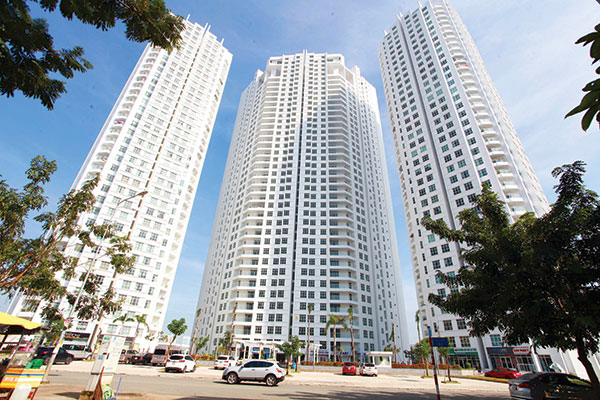Property weathers the storm
 |
| Tran Kim Chung |
A year of improvement
Despite short-term leveling offs, it is fair to say that the real estate market had a good 2016, even improving since 2015, as mirrored by many indicators, such as market liquidity, prices, and the number and scale of new projects.
First, market excitement was maintained throughout the year and across all property segments. In particular, data from the Vietnam Real Estate Association shows that in October 2016 alone there were some 1,300 transactions in Hanoi, up 18.2 per cent on-month, while the figure in Ho Chi Minh City was 1,255 transactions, up 16.7 per cent on-month. Also notably, 2016 saw the debut of many attractive products, for example timeshare condotels which saw vigorous trading on the market.
Second, the price level of products experienced a not-so-drastic increase, especially in the upper-medium bracket. A considerable number of projects were offered at VND50 million ($2,200) per square metre, while some went as high as VND80 million ($3,524). Price-wise, the high-end segment ran laps around the others. This is due to two main reasons: first, investors wanted to offset the high costs accrued since 2013, especially interest costs. Second, newly developed projects were offered at the market price as a result, which was lifted up by earlier projects.
The price hike could also be seen in the landed property segment in 2016. In Hanoi, land prices went up 10-15 per cent on-year in areas like Vinh Ngoc, Dong Tru, Dong Hoi in Dong Anh district or An Khanh-An Thuong in Hoai Duc district. An impressive growth of 25-35 per cent compared to 2015 was recorded in suburban areas near Ho Chi Minh City, in particular District 9 and Thu Duc, Binh Tan, and Nha Be districts.
 |
| Despite worrying factors, the property sector’s outlook for 2017 looks positive overall - Photo: Le Toan |
Also in 2016, a series of “dead projects” were revived, in addition to an increased number of new projects with exceptionally large scale. This is due to the economic stability and warming property market. Mergers and acquisitions played an important role in bringing delayed projects back to life. The list of developers who implemented multiple projects in 2016 is a long one, featuring stars like Vingroup, Sun Group, Novaland Group, FLC Group, Muong Thanh Group, and Dat Xanh Real Estate.
Iconic examples of large scale projects include three projects in Ho Chi Minh City – Vinhomes Central Park (44 hectares), Vinhomes Golden River (25.3 hectares), and Novaland Group’s Lakeview City (30 hectares). In the northern port city of Haiphong, Kinh Bac City Development Holding’s Trang Due Industrial Park expanded its area from 400 to 600 hectares. Other notable projects that made it into headlines are the Hanoi Vingroup housing developments of Vinhomes Times City Park Hill Premium, Vinhomes Gardenia My Dinh, and Vinhomes Metropolis Lieu Giai.
It is important to note that 2016 saw market excitement not only in Hanoi and Ho Chi Minh City, but also in other cities and provinces. Haiphong, Quang Ninh, Danang, Nha Trang, Phu Quoc, Dong Nai, Binh Duong, and Binh Thuan all saw rapid growth in their real estate markets.
In Hanoi and Ho Chi Minh City, new and revived projects were found mainly outside of the central areas, particularly in the South Tu Liem and North Tu Liem districts in Hanoi and Saigon West in Ho Chi Minh City.
As opposed to the periods of 2011-2013 or 2005-2007, large-scale projects were developed very quickly, which implies strong recovery of the market demand and the improved capacity of local developers. Good examples were found in FLC Sam Son Complex, which was completed in only nine months; FLC Quy Nhon Beach and Golf Resort, completed within five months; and resort projects in the central province of Khanh Hoa’s Bai Dai.
Concerns were raised over a potential tightening in credit, after the State Bank of Vietnam issued Circular No.06/2016/TT-NHNN on prudential ratios of credit institutions and foreign bank branches. This lifted the risk index of receivable lending for real estate and securities from 150 to 200 per cent, in addition to lowering the maximum ratio of short-term funds used for medium- and long-term loans from 60 to 50 per cent from January 1, 2017. This ratio will be further decreased to 40 per cent from the beginning of 2018.
However, despite investors’ concerns over capital shortage, the real estate market received good disbursement of capital from financial institutions. Specifically, all banks provided specialised loans for property projects, many even offered 10-20 year loans.
The market was also spurred by remittance and foreign direct investment (FDI) influx. In particular, total remittances reached $12.25 billion in 2015 and $12 billion in 2014, of which 16-17 per cent (approximately $2 billion) was poured into the real estate sector.
On the other hand, statistics from the Foreign Investment Agency under the Ministry of Planning and Investment showed that by the end of October 2016, the property sector attracted the second largest amount of new FDI capital, following the manufacturing sector.
Furthermore, the property market can even call for capital from the securities channel. The fact that the cream of the stock market is doing business in the real estate sector implies a substantial capital inflow.
Likewise, the introduction of derivative instruments had a positive impact on market cash flows via lending programmes, operation of investment funds, and new investment forms, such as mutual funds. And capital from businesses and potential investors has recovered since the slowdown a few years ago.
Limitations remain
Despite the growth in 2016, there were signs of the supply and demand imbalance. While homebuyers were mainly browsing the affordable housing segment, new and revived projects mostly sported mid-range and high-end properties. Reputable developers appear to be keen on luxury products, which accentuated the market imbalance.
The market also saw the boom of the hospitality real estate segment, which attracted a considerable flow of capital. This has made it more difficult for the low-end and social housing segments, usually associated with long payback periods, modest profits, and complicated procedures to access capital.
In addition, there was a slowdown of public investment flows from that of previous years. State-owned enterprises (SOEs) have reduced investments into real estate projects or even divested from the sector. By the end of 2015, nearly VND6 trillion ($264.3 million) was withdrawn from the property sector, accounting for some 34 per cent of SOEs’ total non-core business divestment. In 2016, the divestment was further boosted, mirrored by the VND3 trillion ($132.15 million) divested by the end of August, which had a negative impact on the market.
Three scenarios for 2017
Due to the openness of the local economy, the real estate market in 2017 will be affected by new global economic and political movements – for instance Brexit, new policies of US President Donald Trump, or tensions over the East Sea. There are also local factors, such as macro-economic stability, credit policies, or a supply and demand imbalance which may sway the market heavily. Three scenarios are predicted, based on the impact of the aforementioned factors.
In scenario one, 2017 will be a boom year, provided that certain conditions are met. The global economy must either remain stable or show breakthroughs, the economy must stabilise and receive good capital flows, and Vietnam must host a successful APEC 2017 – not to mention have strong remittance flows.
But this scenario is unlikely. There is almost no chance for the Trans-Pacific Partnership (TPP) to be implemented after Trump announced that he would withdraw the US from the agreement. This would prevent FDI flows from growing sharply in 2017.
Likewise, there is only a faint possibility that the market will get a strong flow of capital, due to the fact that the country’s economic policies – for instance, the new growth model, restructuring, medium-term investment plans, and curbing public debts – are not likely to bring about extraordinary results.
In scenario two, the market will continue to grow gradually. This scenario is most likely to occur unless the global economy sees major changes. In particular, Brexit and Trump’s policy changes will not draw extreme reactions. Stability on the East Sea and well-maintained market capital coming along with fairly good macro-policies are all necessary conditions. If these are met the market is predicted to grow gradually in terms of number of transactions, price level, segments, and products. Investors and speculators will still be on the lookout for good opportunities, but will not turn aggressive in their search.
In the third scenario, the market will decline in 2017. This is the most undesirable scenario, but will happen if a number of conditions come true, including an unimplemented TPP and an unstable East Sea situation. The situation would deteriorate further if macro-economic indicators are not positive and remittance flows dry up or greater divestment of state capital in the real estate sector takes place. Trump’s administration is especially hard to predict, hence it poses risks on the local property market.
In the current context, economies all over the world are moving towards stable development, while signs of confrontation are yet to emerge, especially with the US, China, Russia, Japan, South Korea, the ASEAN, and the EU. Therefore, the second scenario, more or less, is the most likely to happen.
Solutions to sustain development
While external factors are beyond control, a series of local difficulties can be solved to enhance the market’s development. Specifically, state divestment from current SOEs, as well as from real estate projects, needs to be publicised in more detail.
Market forecasts need to be improved to create a basis for policy adjustments amid global market fluctuations. Government-funded projects analysing and predicting the market should be reviewed and reimplemented.
Moreover, the Vietnamese government should continue to complete its institutional framework, especially indicators measuring market developments, such as the House Price Index, the Real Estate Price Index, and the Real Estate Market Index.
In addition, the real estate sector needs more transparency and more accessible information on the status of projects, investors, and developers.
What the stars mean:
★ Poor ★ ★ Promising ★★★ Good ★★★★ Very good ★★★★★ Exceptional
Latest News
More News
- Sun Group breaks ground on $2 billion Van Don casino complex (December 19, 2025 | 18:14)
- Rare, beautiful, sustainable: the mark of iconic real estate (December 19, 2025 | 08:00)
- Owner-occupied housing stabilises, paving the way for new growth cycle (December 18, 2025 | 17:04)
- Unlocking urban potential of smart cities (December 18, 2025 | 16:50)
- Green finance offers 'passport' for Vietnamese construction, building materials firms (December 15, 2025 | 08:00)
- Gamuda Land commit long-term investment (December 12, 2025 | 11:49)
- HITC ties up with Evolution to develop AI and hyperscale data centres in Vietnam (December 11, 2025 | 12:09)
- Real estate deals boom via high-profile names (December 08, 2025 | 11:32)
- Industrial segment shaped by M&As (December 08, 2025 | 08:00)
- The Privé sets the benchmark for luxury real estate (December 05, 2025 | 08:28)
















 Mobile Version
Mobile Version